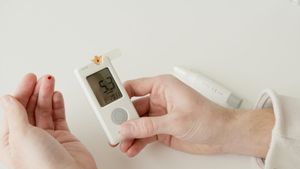JAKARTA - A health observer who is also a cardiologist, dr. Bambang Budiono expressed concern over the dismissal of a well-known doctor by the Indonesian Doctors Association (IDI). Although it did not mention the name of the person who was dismissed, it is no secret that IDI had just revoked the practice permit of the former Minister of Health, Dr. Terawan.
“Recently, online media and television have been colored by the news of the dismissal of a well-known doctor from the IDI membership. The news is getting busier with the rise of community leaders giving testimony stating that so far the person concerned has succeeded in curing thousands of people with therapeutic methods whose benefits are still being debated, and became one of the reasons for the dismissal," said Bambang in a statement received by VOI, Friday, April 8 .
“As a colleague who has taken the oath as siblings, of course we are concerned and sad about this incident, but it is a decision that has been taken at the highest forum of the organization. I'm not going to get into that problem, because I don't have the interest to get involved in the vortex of conflict. What I want to talk about is," he continued.
Doctor Bambang also explained what was the root cause of Terawan's dismissal by IDI, which was related to testing the "brainwashing" method which has not been clinically proven. Bambang explained that in testing the efficacy of a treatment method, there are several methods or methodologies that are commonly used and have been widely accepted in the medical world. Can use intermediate results or "surrogate end point".
“For example, seeing changes in specific markers from laboratory results, seeing changes in special imaging (nuclear cardiology, echocardiography, etc.) used to see the impact of a treatment. It could also be by using clinical data as the final result, such as increasing physical abilities, decreasing the frequency of hospitalization due to heart failure, decreasing the incidence of heart attacks and deaths, and others," he said.
According to him, assessing the superiority of a treatment method, can be done by comparing a new drug or method with standard therapy (if it already exists), or comparing it with an inactive ingredient called a placebo. The best research method if it is randomized or randomized, patients and doctors do not know which is the active drug and which is the placebo, because the placebo packaging is made in such a way that it resembles the shape of the drug or active substance, usually it will be coded and at the end of the new study it is opened to find out which one which is the active substance and which is the placebo.
It should be noted, he continued, that even though the placebo is not an active substance, it can have an impact like the active substance, both in terms of efficacy and side effects. So don't be surprised if there are patients who receive capsules containing flour, there can be a decrease in blood sugar levels, a decrease in blood pressure, a decrease in cholesterol levels, and a reduction in clinical complaints.
"Don't be surprised if patients who receive a placebo complain of side effects similar to active drugs, such as cough, diarrhea, fever, dizziness, and so on. Well, research with a good design will answer whether the drug or method given to the patient really has clinical benefits or not. The more research involved, the stronger the conclusions that can be drawn as to whether or not it is actually better than a placebo," he added.
Understanding about the placebo effect, continued Bambang, it is interesting to retell the true story about the Perkins stick. Elisha Perkins was born in 1741 in Norwich, Connecticut. Elisha Perkins was educated by her father Joseph Perkins in Plainfield, Connecticut, where she later pursued a successful medical education. When the American Revolutionary War broke out, Elisha Perkins served as a surgeon for the Continental Army during the Battle of Bunker Hill. At the end of the 18th century, the development of medicine demanded new findings that could be more promising a cure. As a result, around 1795–96, Perkins invented his "Scepter".
Perkins patented the device for 14 years on February 19, 1796. The wand consisted of two 3-inch metal rods with pointed ends. Despite being made of steel and brass, Perkins claims that his wand is made of an unusual metal alloy.
Perkins claims his wand can cure various inflammations, rheumatism and headaches and facial pain. He applied the dots on the sore body parts and used his wand to do the healing for about 20 minutes. Testimonials by word of mouth made this method booming at that time. Perkins claims this method can "eject the hazardous electrical discharge that is the cause of patient complaints".
The Connecticut Doctors Association condemned the method as "delusional shamanism", and removed Perkins from membership. But Perkins managed to convince three US medical schools that his method worked. In Copenhagen, Denmark, twelve surgeons at the Royal Frederiks Hospital also started to support this method. Other doctors' criticism was met with accusations of elitism and professional arrogance.
Perkins boasts of 5,000 cases his wand has successfully cured. In fact, the healing method was certified by eight professors, forty doctors, and thirty priests. Even the president of Washington was tempted to buy it. Perkins' son, Benjamin Perkins, said that the then President of the United States, convinced of the efficacy of the wand and using it in his own family, bought a set of sticks.
“After Perkins' death, British doctors began to doubt the prowess of his wand. In 1799, Dr. John Haygarth did a trial run. He treated five arthritic patients with a wooden stick made to resemble metal. Four of them reported that the pain was reduced. The next day the patient was treated with a metal rod with the same result. Dr. Haygarth reports his findings in a publication entitled 'On the Imagination as a Cause & as a Cure of the Disorders of the Body'. Attempts to use the wand to heal animals proved futile, perhaps due to the unknown placebo effect in the animal kingdom. At the time, Perkins had many influential supporters and sales of his wand continued. Perkins' son died in 1810. After that the popularity of the Perkins stick began to disappear,” explained Bambang.
Bambang said the story "Perkins stick" shows how much influence a placebo effect has, when patients believe that it can heal. No wonder, according to him, if the 'Ponari stone' has ever succeeded in curing various diseases in hundreds of people.
“It should be understood that the medical world does not provide a place for testimony because it cannot be tested. Even if spoken by a minister or even the president, testimony will never have the value of clinical evidence," he concluded.
The English, Chinese, Japanese, Arabic, and French versions are automatically generated by the AI. So there may still be inaccuracies in translating, please always see Indonesian as our main language. (system supported by DigitalSiber.id)













